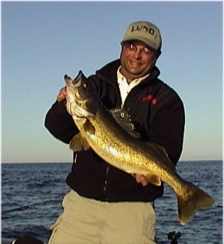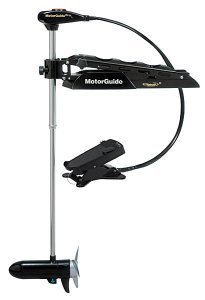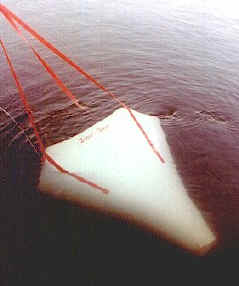


















 Mark Martins
Lake
Superior Beachfront home for rent
Mark Martins
Lake
Superior Beachfront home for rent


|
 |
Boat control can mean everything when it comes to consisitently
catching fish like this. You have to learn to deal with the day to
day changes in wind waves, temperature conditions and more. |
Speaking out on Boat Control
by Mark Martin
Are you going to let the Mother Nature dictate whether or not you go fishing?
I say it’s a shame to let it happen, save for under perilous conditions
like electrical storms, when it makes perfect sense to wait the weather
out. But when your adversary’s the wind, you can confront it with the right
equipment and knowledge of boat control.
You see, I know the score all too well, having fished many tournaments
when the wind has gone from flat calm to 25 mph in a moment’s notice. It’s
a common occurrence everywhere from the Great Lakes to the gusty Dakotas.
So now, after far more than a decade of competitive fishing, I always go
prepared with powerful batteries, wind socks and a presentation that will
stay on bottom in the walleye zone. This is a straightforward roster that
will keep you fishing—and catching—when it would otherwise be tempting
to camp out on shore.
Got Juice?
Perhaps the most important ingredient to boat control is contained
in your storage compartments—your deep-cycle batteries. Everyone knows
there’s nothing more frustrating than running out of juice when you’re
pitching and yawing in the waves. After all, it renders your fishing trip
futile.

MotorGuide
Tour Edition |
That’s why I have a full complement of workhorses under the hood of
my Lund 2025. In fact, I have five Trojan
deep-cycle batteries to run my trolling motors, electronics and other equipment.
Three of them power my 107-pound-thrust Motor Guide trolling motors. On
the bow is a foot-pedal model with a 60-inch shaft to keep the prop from
popping out of the water in the waves. On the transom is another with a
45-inch shaft. With their long shafts, both dig in to the water to provide
powerful thrust under adverse conditions But even their tremendous
utility would be lost without batteries that keep going and going. . |
My choice from Trojan (Trojan Battery: 800-423-6569; www.trojan-battery.com)
is the company’s SCS 225, the largest deep-cycle power sources, in terms
of the energy they store, you can put in your boat. This particular battery
has a 225-minute reserve capacity, which means the batteries will supply
power for that long when drawing 25 amps. But most trolling motors use
between 5 and 15 amps, which means the Trojans will last far longer. Bonus:
Trojan batteries seldom need water, which makes for far less maintenance
than with other brands. (Still, as often as I use mine, I check the water
levels about once a month.)
A case in point of the Trojans’ longevity was at a recent tournament
where I had fished all day in three-foot waves. That night, when the on-board
charger was plugged in, someone tripped over the power cord and disconnected
it from the outlet. The next day, without an overnight charge, I was still
able to fish a full eight hours without running out of electricity. Talk
about reliability.
A Sock in It

JNB Originals Wave Tamer |
To complement the electric motors and their batteries, I turn to wind
socks to further control and slow the boat in difficult conditions. Wherever
I go, I take three wind socks from JNB Originals called Wave Tamers—models
that span 30, 40 and 52 inches at their openings. The biggest one is effective
in winds of up to—gulp—40 mph. (J&B Originals: 507-629-3969; www.driftbag.com.)
The best part about the Wind Tamer is a spring that pops the drift sock
open without it collapsing and polyester construction that keeps it from
deteriorating in the sunlight or when wadded up during storage. |
Add to that the fact that the drift sock floats, and you've got the real
deal for slowing a boat to a crawl in wind and waves—without losing it
if it does come detached from the boat.
Such wind socks are key for following structure when you otherwise
wouldn’t be able to. I like to tie the bag as close to the boat as possible,
on the upwind side, in order to keep the bow and the electric motor in
the water. When I’m running my bow mount, I position the sock on a cleat
as close to the bow as possible. If I’m backtrolling, I attach the chute
to the bow cleat or bow eye. When the wind is especially serious, I’ll
even put out two of them.
Buoyant Bait
Of course, under these conditions it’s still easy to lose contact with
bottom with most presentations. For walleyes in rough water, one of the
best bets to stay in the zone is a Northland (www.northlandtackle.com)
Rock-Runner bouncer trailed by a spinner.

Northland
Float and Spin |
The heavy lead, which comes in two- and even three-ounce sizes, will
keep a bait down near bottom on a tight line. Behind the bouncer I put
a Northland Float ’n Spin, a spinner rig with a float to keep the offering
up in the fish’s eyes. |
For added buoyancy, I inject a night crawler with air in the nose, collar
and tail. Heck, it almost looks like a hot dog, but the puffed-up bait
will allow you to go super slow to trigger fish in frontal conditions.
Plus, the inflated rig keeps you from dragging across zebra mussels and
whatnot littering the bottom. Even if the blade doesn’t spin in a full
rotation, it’s all right. Often a back-and-forth wobble of the blade is
just the ticket to trip a walleye’s trigger.
So who said fishing in high winds was impossible? It’s not if you have
the equipment and resolve to keep both boat and bait in the proper position.

 
International
Fishing Banner Exchange
Walleyes Inc. website is maintained
by Randy
Tyler Fishing the In-Fisherman Professional Walleye Circuit, Masters
Walleye Circuit and the Team Walleye Circuit. All rights reserved.Copyright
1999/2001
Please visit these site sponsors
Daiichi/Tru-Turn Hooks,
Lindy
Little Joe,
R-A.M Mounting Systems,
Ranger
boats, Mercury Marine, Bedford
Sales , Hamby's Beaching Bumpers,
Goldeneye
Marine products, Panther
Marine Products, Webfoots body
sock,
Bait Rigs Tackle
|

 Mark Martins
Mark Martins



